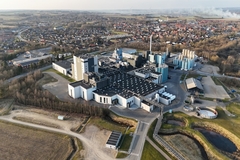
- Industry news
Industry news
- Category news
Category news
- Reports
- Key trends
- Multimedia
Multimedia
- Journal
- Events
- Suppliers
- Home
- Industry news
Industry news
- Category news
Category news
- Reports
- Key trends
- Multimedia
Multimedia
- Events
- Suppliers
Consumers bargain, buy bulk and bounce on brands amid grocery inflation, IRI flags
.png)
10 Aug 2022 --- Consumers are reacting to food inflation by making value choices like opting for value-packed products, discounts on offerings with marked-down prices and moving away from luxury brands to cheaper in-house brands.
The insights, published by The Information Resources Inc. (IRI), are based on the most recent point-of-sale data and incorporate information from all US food distribution channels, including e-commerce.
According to data from July, prices for consumer products across categories are still elevated.
Krishnakumar Davey, president of Thought Leadership for Consumer Packaged Goods and Retail comments on grocery retailing and says that “consumers are responding to rising prices by shopping promotions, prioritizing value options and trading down to avoid going without.”

Davey says that retailers must have the tools to quickly adjust to changes in consumer preferences to ensure they are offering the right assortment at price points that appeal to price-sensitive shoppers and their most valuable customers.
Persistent inflation
Inflation in food and beverages is still present both sequentially and annually, despite recent price declines in other sectors of the economy, such as fuel.
.png) Davey says that consumers are responding to rising prices by shopping promotions.Refrigerated eggs, for example, rose 5.9% in June versus May, and 46.8% when comparing July 2021 and July 2022.
Davey says that consumers are responding to rising prices by shopping promotions.Refrigerated eggs, for example, rose 5.9% in June versus May, and 46.8% when comparing July 2021 and July 2022.
Frozen dinners and entrees have seen a steep incline, with an increase of 3.5% between June and July 2022, while the yearly difference between July 2021 and July 2022 is a 22.8% growth.
Even while the cost of several food categories has started to drop recently, year-over-year prices tend to stay high, providing consumers with little relief. Observing the category with the largest decrease in price, fresh citrus fruits have decreased 2.4% from June 2022 to July 2022, yet remain at a 26.7% increase comparing July 2021 and July 2022.
Quantity catches the eye
The IRI has observed that consumers are opting for value-oriented categories to preserve quantity and, despite the inflation of prices, food and beverages’ total volume and units have remained steady.
However, data showing the 13-week period ending July 10, 2022, compared to the prior 13-week period shows that they are buying less expensive meal options and opting for ingredients that fill, such as pasta, rice, frozen potatoes and canned soup.
Sports drinks, ready-to-drink coffee and tea, frozen novelties, refrigerated entrées, and frozen meals and entrées are just a few of the categories in which consumers are buying less.
Consumers are bargain hunting
The IRI found that as supply chain issues relax and shoppers become more price-sensitive, promotional activity – such as weekly discounts and coupons – is reverting to pre-pandemic levels in many food and beverage categories.
When there are promotions available, consumers are said to react. Over the preceding four weeks ending July 10, 2022, the proportion of sales grew “dramatically” in several grocery retailing categories where promotions and discounts were prevalent.
According to the IRI’s recent statistics, the top five food and beverage categories with an increase in promotions and discounts in these aforementioned weeks, closely resemble the same four weeks in 2019 prior to the pandemic, with approximately half of these categories’ sales coming from advertised goods.
For instance, 55% of ice cream and sherbet purchases over the four-week period were made at discounted prices, an increase of 9 percentage points from two months prior. .png) Consumers are opting for value-oriented categories to preserve quantity.
Consumers are opting for value-oriented categories to preserve quantity.
Furthermore, 13 percentage points higher category sales were generated by these promotions than they were two months prior, totaling 93% more.
Looking for labels
In addition, the IRI found that consumers are switching from a preferred brand or higher-priced product for one at a lower price point. In many product categories, including spirits, cheaper value brands displaced premium and super premium spirits and increased their share by 73.6% in the 13 weeks ending July 31, 2022, compared to the prior 13 weeks.
Private labels continue to expand in several food categories as consumers move away from national brands and into commodity categories or areas where store brands are already well-known.
The categories of fresh eggs, sugar, sour cream, shortening and oil, butter and margarine blends, flour, frozen meat, and bottled water had the largest increases in private label share for the four weeks that ended on July 24, 2022.
Prioritizing premium products
Consumers are trading down on minor luxuries in order to trade up on larger ones, mirroring behavior from the 2008 recession. As a result, premiumization in some categories persists despite rising inflation.
For instance, in the same 13-week comparison, the total sales share for premium and super-premium imported beer increased 2.6 percentage points to 51.2% of category sales.
The share of more expensive goods in the premium category has increased by roughly one percentage point in a few other categories, including frozen dinners/entrées and refrigerated juices and beverages.
The IRI also reported slower spending outside of food and beverage. Foil pans, home cleaning cloths, toilet paper, face tissue, laundry detergents and household cleaners are just a few of the products that consumers are buying fewer of.
Edited by Mieke Meintjes










